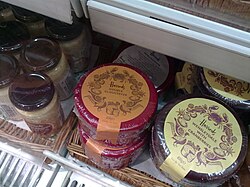
Cheddar cheese is a natural cheese that is relatively hard, off-white, and sometimes sharp-tasting. It originates from the English village of Cheddar in Somerset, South West England.
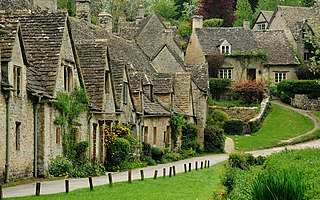
Gloucestershire is a ceremonial county in South West England. It is bordered by Herefordshire to the north-west, Worcestershire to the north, Warwickshire to the north-east, Oxfordshire to the east, Wiltshire to the south, Bristol and Somerset to the south-west, and the Welsh county of Monmouthshire to the west. The city of Gloucester is the largest settlement and the county town.

Manchego is a cheese made in the La Mancha region of Spain from the milk of sheep of the Manchega breed. It is aged between 60 days and 2 years.
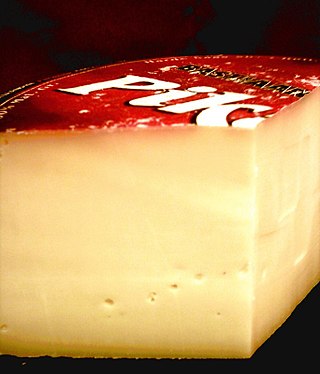
Gouda cheese is a creamy, yellow cow's milk cheese originating from the Netherlands. It is one of the most popular and produced cheeses worldwide. The name is used today as a general term for numerous similar cheeses produced in the traditional Dutch manner.

Brie is a soft cow's-milk cheese named after Brie, the French region from which it originated. It is pale in colour with a slight greyish tinge under a rind of white mould. The rind is typically eaten, with its flavour depending largely upon the ingredients used and its manufacturing environment. It is similar to Camembert, which is native to a different region of France. Brie typically contains between 60% and 75% butterfat, slightly higher than Camembert.
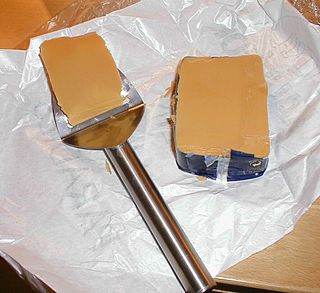
Brunost is a common Norwegian name for mysost, a family of soft cheese-related foods made with whey, milk, and/or cream. The characteristic brown color and sweet taste result from milk sugars being caramelized after boiling. The term brunost is often used to refer to fløtemysost or Gudbrandsdalsost, which are the most popular varieties.

String cheese is any of several different types of cheese where the manufacturing process aligns the proteins in the cheese, making it stringy.

Stilton is an English cheese, produced in two varieties: blue, which has Penicillium roqueforti added to generate a characteristic smell and taste, and white, which does not. Both have been granted the status of a protected designation of origin (PDO) by the European Commission, requiring that only such cheese produced in the three counties of Derbyshire, Leicestershire and Nottinghamshire may be called Stilton. The cheese takes its name from the village of Stilton, now in Cambridgeshire, where it has long been sold, but cannot be made because it is not in one of the three permitted counties.

Red Leicester is an English cheese similar to Cheddar cheese, but crumbly in texture. It is typically aged 6 to 12 months. The rind is reddish-orange with a powdery mould on it. Since the 18th century, it has been coloured orange by the addition of annatto extract during manufacture. It is a cow's milk cheese, and is named after the city of Leicester, or the ceremonial county it is located in, Leicestershire.

Lancashire is an English cow's-milk cheese from the county of Lancashire. There are three distinct varieties of Lancashire cheese. Young Creamy Lancashire and mature Tasty Lancashire are produced by a traditional method, whereas Crumbly Lancashire is a more recent creation suitable for mass production.

The Cooper's Hill Cheese-Rolling and Wake is an annual event held on the Spring Bank Holiday at Cooper's Hill, at Brockworth near Gloucester, England. Participants race down the 200-yard (180 m) long hill chasing a wheel of Double Gloucester cheese. It is uncertain when the tradition first began, and is possibly much older than its earliest known written attestation in 1826. The event has a long tradition, held by the people of the village, but now people from a wide range of countries take part in the competition as well. The Guardian called it a "world-famous event," with winners coming from Australia, Belgium, Canada, Egypt, Germany, Japan, New Zealand, and the United States.

Stinking Bishop is a washed-rind cheese produced since 1972 by Charles Martell and Son at Hunts Court Farm, Dymock, Gloucestershire, in the west of England. It is made from the milk of Old Gloucester cattle.
Crowdie is a type of soft, fresh cheese made from cows' milk, traditionally from Scotland.
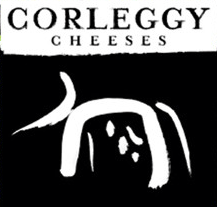
Corleggy Cheeses is an Irish cheese producer in County Cavan. It was started by Silke Cropp in 1985 using milk from her own goat herd. Today Corleggy make a variety of different cheese from goat's milk, sheep's milk and cow's milk sourced from local farmers.

The Old Gloucester or Gloucester is a traditional British breed of cattle originating in Gloucestershire and surrounding areas in the West Country of England. It was originally a triple-purpose breed, reared for milk, for beef and for draught use; it is now a dual-purpose animal. It is an endangered breed, and its conservation status is listed as "priority" by the Rare Breeds Survival Trust.

Derby cheese is a mild, semi-firm British cow's milk cheese made in Derbyshire with a smooth, mellow texture and a buttery flavour. Like most of the traditional British hard cheeses it was produced exclusively on farms and was typically sold at a younger age than its more famous cousins Cheddar and Cheshire. It has a pale, golden orange interior with a natural or waxed rind and ripens at between one and six months. In many respects Derby is similar to Cheddar in taste and texture, but with a softer body and slightly higher moisture content. When young it is springy and mild but as it matures subtle sweet flavours develop and the texture becomes firmer.

There are many different types of cheese, which can be grouped or classified according to criteria such as: length of fermentation, texture, production method, fat content, animal source of the milk, and country or region of origin. These criteria may be used either singly or in combination, with no method used universally. The most common traditional categorization is based on moisture content, which is then further narrowed down by fat content and curing or ripening methods.
Fivemiletown Creamery is based in Fivemiletown, County Tyrone, Northern Ireland, and is a producer of handmade speciality soft cheeses and cheddars The company is a farmers' co-operative, and employs around 40 people. The creamery draws its milk supplies mostly from over 60 dairy farmers from across Northern Ireland. The company was founded in 1898 and added cheese production in 1972. Fivemiletown Creamery is the only speciality cheese maker in Northern Ireland. In 2014 Fivemiletown Creamery was acquired by Dale Farm.
